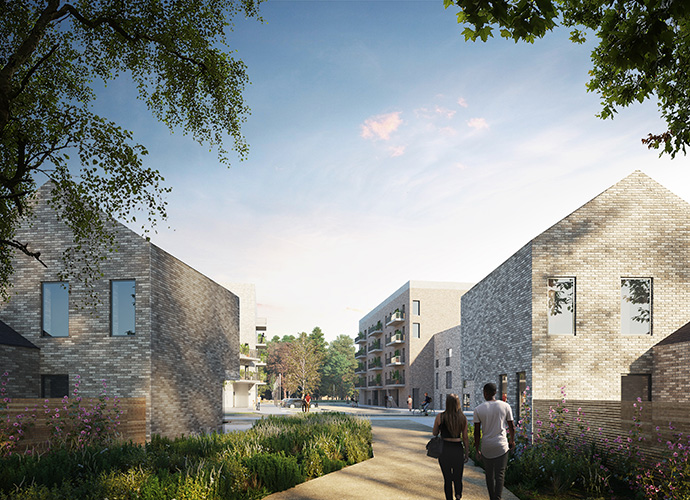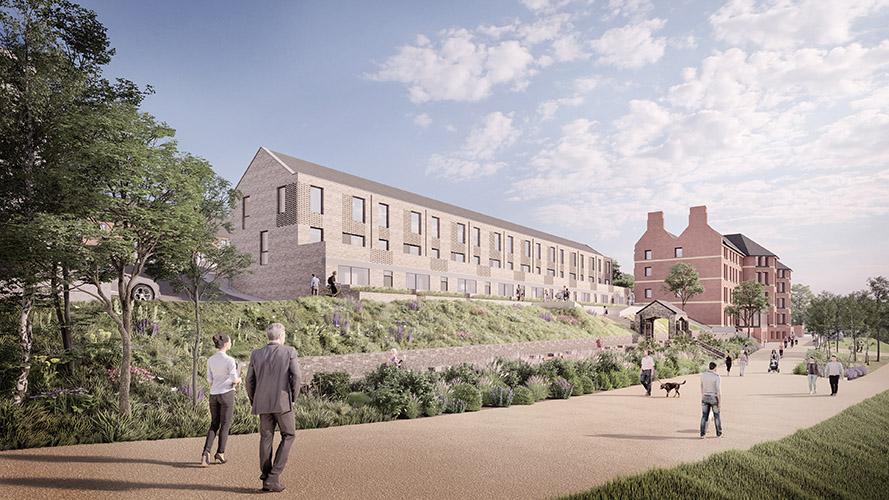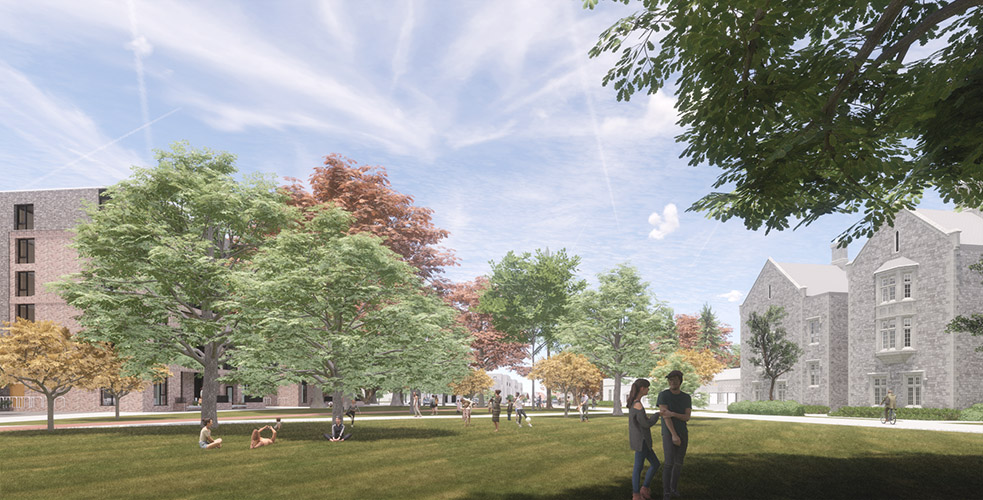“Sustainability must be front and centre in all construction decisions”


As the Land Development Agency breaks ground on its first projects, LDA Head of Property and #BuildingLife Ambassador Phelim O’Neill speaks with ROBBIE COUSINS about the agency’s goal of achieving an annual output of 2,000 residential units and the central role of sustainability in its operations.
The Land Development Agency (LDA) is a commercial state-sponsored body established in 2018 on the back of the objective of Project Ireland 2040 (PI2040) to coordinate land within state control for more optimal uses where appropriate, with a focus on the provision of housing.
Phelim O’Neill, Head of Property, LDA, was one of then three staff members to open the LDA offices in early 2019. Today, the body employs 70 people and is beginning on-site works on two major sites in Dublin and Cork, the first of many large-scale projects over the coming years.
O’Neill recalls, “We started with three of us in 2019. By the beginning of Covid-19 in early 2020, we had 12 people, and now we have about 70 members of staff.”
The LDA is structured much like a developer, with construction, planning, property, investment, finance, procurement, legal and operations teams, and it is very much continuing to scale up.
As it starts scaling up to become a key developer on the national landscape, Phelim O’Neill notes that the LDA has nearly 2,400 units in planning at this time, with more to be lodged shortly, and it is expecting decisions imminently on a number of these schemes.
“More importantly, we’re going to site with two substantial schemes in the coming weeks. The larger of these is the Shanganagh public housing project in south Dublin. This is a partnership with Dun Laoghaire-Rathdown County Council and comprises 597 public homes, including cost rental, affordable sale and social units; Walls Construction has started work in September with a Design & Build contract. Our St Kevin’s Hospital site in Shanakiel, overlooking Cork city, on an HSE site, is also about to go on site with enabling works for 265 homes.”
Land Development Agency resources
Two key points have enabled the LDA to move quickly. Firstly, it had access to a substantial state landbank, and, secondly, it has been given access to capital.
“We secured access to finance when the Land Development Act 2021 was enacted last year. We have an initial equity capital base of €1.25bn, committed from the Irish Strategic Investment Fund through the government. We can borrow a further €1.25bn, and the government has indicated that another €1bn will be made available. This gives us a total firepower of up to €3.5bn, which enables us to progress projects much quicker, as seen with the fast turnaround of Shanganagh and St Kevin’s.
LDA frameworks
Phelim O’Neill adds that as LDA output grows, it will need structures in place to secure resources and contractors.
“We are actively looking at frameworks as a means to deliver projects as we scale up. We’ve already set up frameworks for professional services that we use to progress projects. As we move towards the delivery phase, frameworks for contractors are very much on our agenda. But we know that we need to have enough of a pipeline of similar type projects to make the frameworks attractive.”
He says that the past four years have been about setting up and getting to a point where the LDA can get projects on site. But now, it is looking to scale up the number of on-site projects and unit delivery.
“Our first units from householder partnerships will be completed later this year, with the first units from direct delivery state lands, Shanganagh and St Kevin’s, being delivered in 2024. There will be a significant ramp-up in activity across the country from there, as other projects come through the planning process. Our goal is to have an annualised output of 2,000 units later this decade, all or the vast majority being public housing.
“As part of this process, we will be looking at larger sites in major towns that have been identified in the National Development Plan (NDP) and PI2040. We will complement the output of local authorities and other bodies, focusing on larger-scale sites that are capital and labour intensive.”
He adds that the LDA has developed good working relations with local authorities and utility companies.
“Collaboration with local authorities has been a big win-win. We have good relationships across the country and active partnerships in place with several, Shanganagh with Dun Laoghaire Rathdown County Council being one example. We have a strategic partnership in place with Cork City Council to resource the Cork Docklands Delivery Office. This will work to deliver Ireland’s largest regeneration project, which has attracted approved infrastructure funding of €350m.
“We also have good relations with the utility companies. But, that being said, we recognise the challenges ahead, such as capacity and network issues, all of which will have to be actively managed. The LDA has the same issues as other developers but is working with the various bodies towards achieving solutions.”

Sustainability
He points out that the LDA has had sustainability embedded in operations from day one.
“We adopted the Home Performance Index (HPI), which is run by the Irish Green Building Council (IGBC). This gives us many metrics that look at numerous criteria, not just the typology or density. It looks at location, transport, biodiversity, etc. So, it gives us a great baseline to benchmark schemes.
“The sustainability criteria we have put in place for Shanganagh and St Kevin’s underpins our desire to be seen as the market leader in the sustainability space.
“Shanganagh will be delivered to a passive standard and at 540 apartments, it will be the largest passive house apartment scheme in the world. This is not an insignificant feat, given the construction and supply chain issues that the sector has to deal with at this time. Getting this project delivered will build market confidence for contractors that passive houses can be delivered at scale.”
Phelim O’Neill says that credit must also be given to Dun Laoghaire Rathdown Council for specifying that passive standard some years ago.
“They have shown great foresight in this area and have helped build market confidence that the delivery of large-scale housing to passive standards can be done.
“St Kevin’s, as with many other schemes we will be developing, will be built on a strategic brownfield site, with adaptive reuse of original structures. While not without its obvious challenges, one of the effective things to do to drive sustainability is to adapt existing structures and use brownfield sites that benefit from existing transport networks, infrastructure and the social network of an area. I think that we’ve done that very successfully with our plans for St Kevin’s.”
Whole-life carbon
Phelim O’Neill explains that looking at the whole-life carbon element of any development is one of the keys to its sustainability.
“Managing construction inputs is only one part of reducing the whole-life carbon impact of a development. Because we have a cost rental model for many of the units we are developing, we want to fully understand and design for the full life cycle of our buildings.
“So, our starting point is to design for a sustainable future. To this end, we part-funded a Whole Life Cycle Carbon Counter with the Environmental Protection Agency (EPA) and the IGBC. This is an early-stage tool that looks at the possible outcomes of different options considered for developments.
“The key challenge is to have enough reliable information to look at and understand the different options we can use to increase sustainability.
“As an island nation with a small market in the context of the world economy, Ireland is not a hugely attractive market to some manufacturers as, say, much of the rest of Europe and the UK. Because of this, the sector as a whole will have to work collaboratively across public, private, and various agencies to attract larger operators into the Irish market and give them confidence that there is a strong pipeline of orders that can be achieved while also supporting and growing our indigenous capacity.”
#BuildingLife campaign
Phelim O’Neill says that the whole life carbon of the built environment is on everyone’s radar now “because, quite simply, it’s now on end-users’ radars, whether it be a commercial building, workplace, homeowner or tenant.
“Energy efficiency or sustainability is no longer about wanting to build an A-rated unit, it now requires a more sophisticated and holistic approach. It covers every part of the building process and the building’s life cycle. It is driven by end-user requirements as much as corporate strategies. Sustainability must be front and centre of all decision-making across the entire construction sector.
“Sustainability is a key pillar of the LDA business plan, and the IGBC is the market leader in this space. As we had already been working with the IGBC, #BuildingLife was an obvious tie-in, particularly with the Shanganagh project and the fact that it was passive housing at scale.
“The IGBC and our passive housing consultant Mosari were key in bringing us up the learning curve and increasing our knowledge, so that we can be active and effective in this space.”
O’Neill adds that a big challenge with whole-life carbon is procurement. “As an island nation, we are limited in terms of specifying, particularly at this time when resources and supply chain are challenged. The availability of product options is a limiting factor, but Environmental Product Declarations (EPDs) can be used in the design specification to drive sustainability.
Early team involvement
“From a property perspective, we’re dealing with projects from site assessment all the way through to asset management. Creating awareness and establishing a culture that considers whole-life carbon impacts at early stage decision making is essential. The earlier you consider this, the more impact you can have over the lifetime of the entire building. Bringing in everybody early from our own internal team, external teams, contractors and delivery partners is the best way forward.
“Everyone needs to be thinking about how we drive sustainability for the entirety of the lifecycle of a building or scheme.”
Modern methods of construction
Phelim O’Neill comments that MMC, digital construction, and lean construction are critical to growing LDA’s operations.
“We are looking at how to support the indigenous Irish MMC market as well as learning from markets that are far more mature in the MMC sector. It will require a concerted effort at scale across a number of agencies to manage compliance for existing systems and technologies entering the Irish market. The LDA is collaborating with the Construction Sector Group and Enterprise Ireland to try and unlock the obvious potential for this sector.”
Land Development Agency projects
The LDA has several high-profile schemes in planning at the moment on which decisions are expected imminently. Most notably, the Central Mental Hospital site in Dundrum, Dublin, has a planning application for 997 homes. Elsewhere, applications are submitted for over 800 homes in Balbriggan, 220 in Naas and 345 units in Skerries. Adding other schemes currently in planning, the LDA has about 3,000 units in planning or near planning stage at this time.
As the LDA moves towards its goal of delivering 2,000-plus units a year through its various delivery mechanisms, its available landbank will be even more important. It will, however, take time to build up to that level of output.
“In order to first achieve such delivery ambitions, we need to have a significant landbank going through planning, design, procurement and tendering. We need to keep our pipeline strong. Having the state lands database allows us to consider opportunities for the future with the state landbank, but we will also need to consider non-state lands to meet these ambitious targets. This is why we have collaborated with those in control of private land through our Project Tosaigh initiative.”
Project Tosaigh
Initially using a forward purchase model, with housebuilder partners that have control of planning consented land, Project Tosaigh is a framework that can unlock short-term delivery in the market where developments may have stalled or have not commenced due to financing and other commercial constraints, where existing planning permissions in sustainable locations have not commenced or are not delivering as quickly as they should, the LDA is looking to deploy its resources to expedite much-needed housing delivery, with predominantly cost rental units.
“We have a target of 5,000 units between now and 2026 through this initiative. Under Project Tosaigh, there was an open call for proposals late last year, which received a strong response. There are now several schemes that are going through their due diligence and negotiations, and we hope to make announcements of delivery shortly.”

In conclusion
As the LDA brings its first projects to site, Phelim O’Neill says that what has been achieved over the past three years would not have been possible without the support of partnering organisations, “The partnership approach taken with local authorities to date has meant that by working together, we have been able to progress significant development opportunities to help address our national housing crisis.
“This squarely positions the LDA as being a partner and service provider to local authorities and not in competition with them. The LDA is an enabler for local authorities by way of project delivery, financing and property management solutions, while local authorities have been enablers of the LDA through land provision, community relationships and their technical background knowledge base.
“The Shanganagh project with Dun Laoghaire Rathdown County Council has led to other significant projects, such as St Teresa’s Gardens with Dublin City Council. We are constantly engaging with Fingal and South Dublin County Councils to see how we can work together on future delivery. We are also working closely with Cork City, Limerick City and County, Galway City Council and Waterford County Councils to drive housing delivery.
“These partnerships are a testament to our team’s collaborative approach to working with bodies in various sectors and have given people the confidence to trust the LDA to deliver large-scale strategic projects. We must continue to build on the progress to date and maximise delivery into the future,” Phelim O’Neill concludes.





